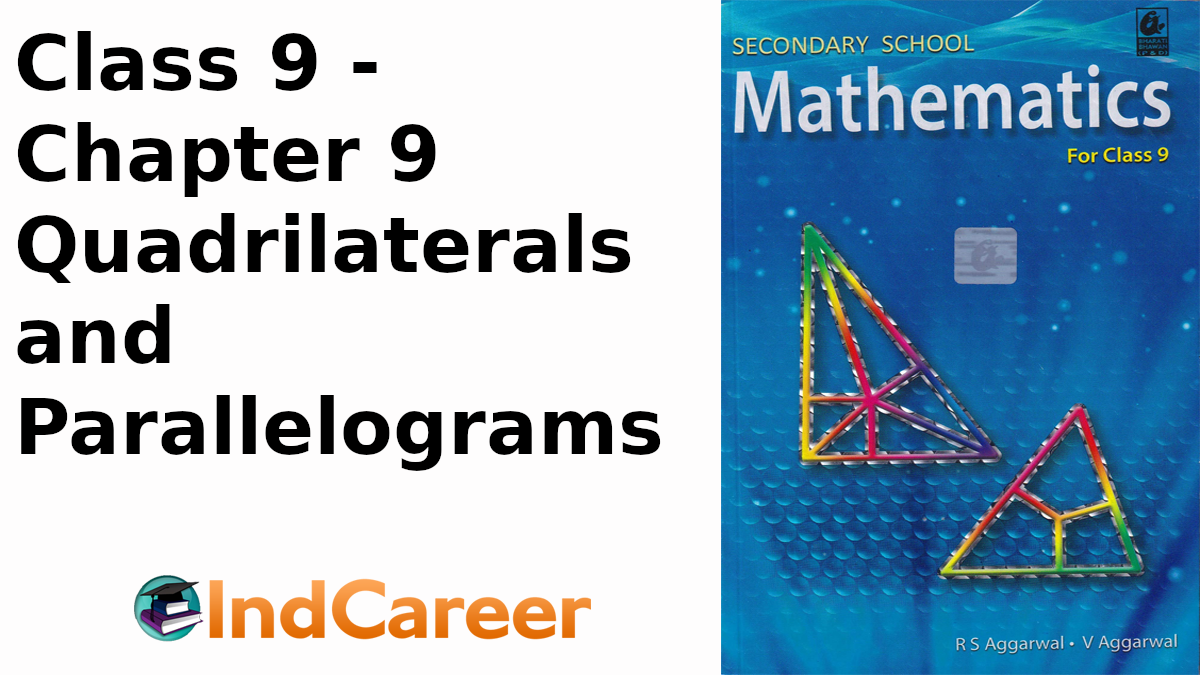Class 9: Maths Chapter 9 solutions. Complete Class 9 Maths Chapter 9 Notes.
Contents
RS Aggarwal Solutions for Class 9 Maths Chapter 9–Quadrilaterals and Parallelograms
RS Aggarwal 9th Maths Chapter 9, Class 9 Maths Chapter 9 solutions
Ex 9A Solutions
Question 1.
Solution:
We know that sum of angles of a quadrilateral is 360°
Now, sum of three angles = 56° + 115° + 84° = 255°
Fourth angle = 360° – 255° = 105° Ans.
Question 2.
Solution:
Sum of angles of a quadrilateral = 360°
Their ratio = 2 : 4 : 5 : 7
Let first angle = 2x
then second angle = 4x
third angle = 5x
and fourth angle = 7x
∴ 2x + 4x + 5x + 7x = 360°
=> 18x = 360°
=> x = 360o18 = 20°
Hence, first angle = 2x = 2 x 20° = 40°
Second angle = 4x = 4 x 20° = 80°
Third angle = 5x = 5 x 20° = 100°
and fourth angle = 7x = 7 x 20° = 140°Ans.
Question 3.
Solution:
In the trapezium ABCD
DC || AB
∴ ∠ A + ∠ D = 180° (Co-intericr angles)
∴ 55°+ ∠D = 180°
∠D = 180° – 55°
∴ ∠D = 125°
Similarly, ∠B + ∠C = 180°
(Co-interior angles)
=> 70° + ∠C = 180°
=> ∠C = 180° – 70°
∠C = 110°
Hence ∠C = 110° and ∠D = 125° Ans.
Question 4.
Solution:
Given : In the figure, ABCD is a square and ∆ EDC is an equilateral triangles on DC. AE and BE are joined.
To Prove : (i) AE = BE
(ii) ∠DAE = 15°
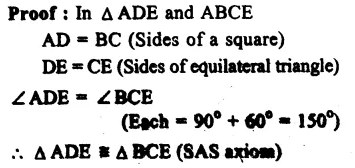
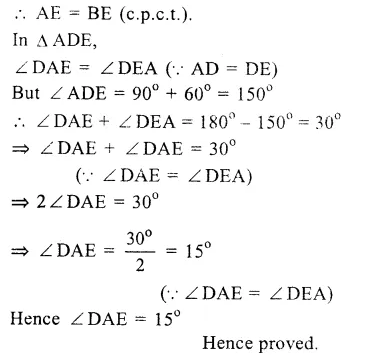
Question 5.
Solution:
Given : In the figure,
BM ⊥ AC, DN ⊥ AC.
BM = DN
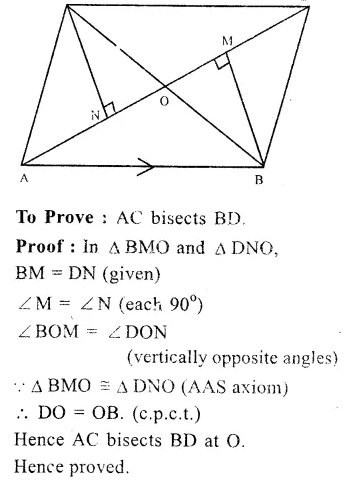
Question 6.
Solution:
Given : In quadrilateral ABCD,
AB = AD and BC = DC
AC is joined.
To Prove : (i) AC bisects ∠ A and ∠ C
(ii) BE = DE
(iii) ∠ABC = ∠ADC
Const. Join BD.
Proof : (i) In ∆ ABC and ∆ ADB
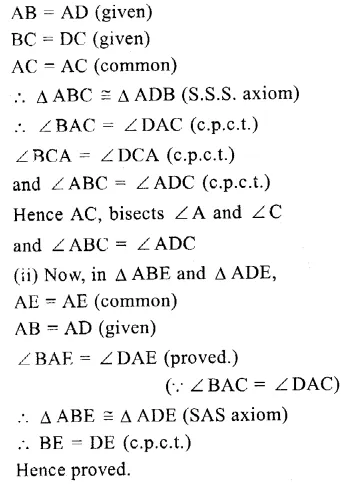
Question 7.
Solution:
Given : In square ABCD,
∠ PQR = 90°
PB = QC = DR
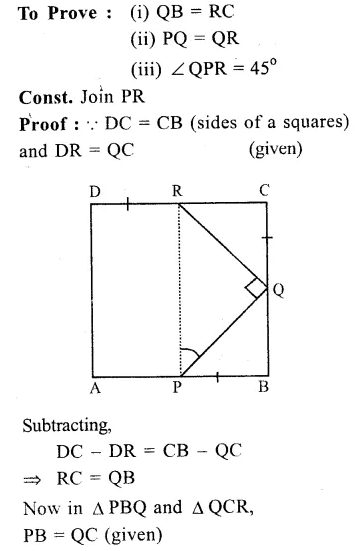

Question 8.
Solution:
Given : In quadrilateral ABCD, O is any point inside it. OA, OB, OC and OD are joined.
To Prove : OA + OB + OC + OD > AC + BD
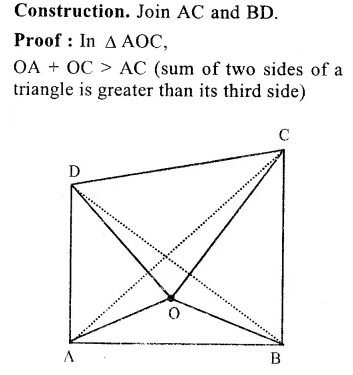

Question 9.
Solution:
Given : In quadrilateral ABCD, AC is its one diagonal.
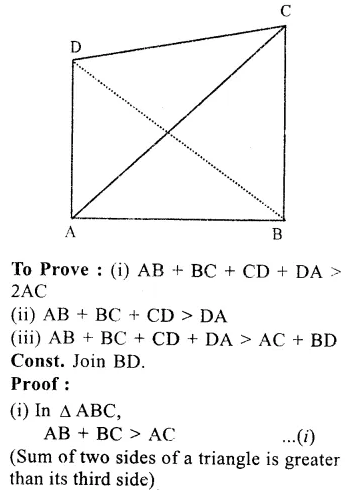
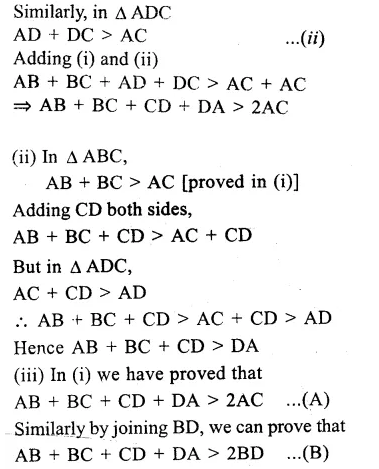
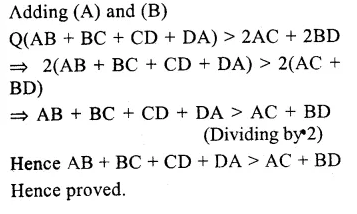
Question 10.
Solution:
Given : A quadrilateral ABCD
To Prove : ∠A + ∠B + ∠C + ∠D = 360°
Const. Join AC.
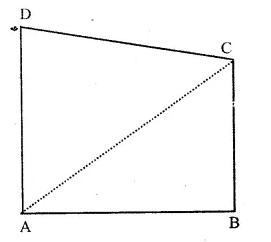
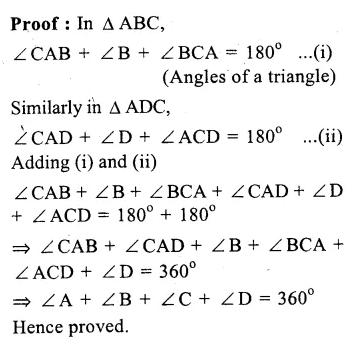
Ex 9A
Question 1.
Solution:
In parallelogram ABCD.
∠ A = 72°
But ∠ A = ∠ C (opposite angle of a ||gm)
∴ ∠ C = 72°
∴ AD || BC
∴ ∠ A + ∠ B = 180° (co-interior angles)
=> 72° + ∠B = 180°
=> ∠B = 180° – 72°
=> ∠B = 108°
But ∠ B = ∠ D (opposite angles of a ||gm)
∴ ∠D = 108°
Hence ∠D = 108°, ∠ C = 72° and ∠ D = 108° Ans.
Question 2.
Solution:
In || gm ABCD, BD is its diagonal
and ∠DAB = 80° and ∠DBC = 60°
∴AB || DC
∴∠DAB + ∠ADC – 180°
(co-interior angles)
=> 80° + ∠ADC = 180°
=> ∠ ADC = 180° – 80°
=> ∠ ADC = 100°
But ∠ ADB = ∠ DBC (Alternate angles)
∴∠ ADB = 60°
But ∠ ADB + ∠ CDB = 100°
(∴∠ ADC = 100°)
60° + ∠CDB = 100°
=> ∠CDB = 100° – 60° = 40°
Hence ∠CDB = 40° and ∠ ADB = 60° Ans.
Question 3.
Solution:
Given : In ||gm ABCD,
∠ A = 60° Bisectors of ∠ A and ∠ B meet DC at P.
To Prove : (i) ∠APB = 90°
(ii) AD = DP and PB = PC = BC
(iii) DC = 2AD
Proof: ∴ AD || B (opposite sides of a ||gm)
∴∠ A + ∠ B = 180° (co-interior angles)
But AP and BP are the bisectors of ∠A and ∠B
∴12∠A + 12 ∠B = 90°
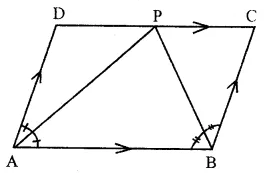
=> ∠PAB + ∠PBA = 90°
But in ∆ APB,
∠PAB + ∠PBA + ∠APB = 180° (angles of a triangle)
=> 90° + ∠APB = 180°
=> ∠APB = 180° – 90° = 90°
Hence ∠APB = 90°
(ii) ∠ A + ∠ D = 180° (co-interior angles)
and ∠ A – 60°
∴ ∠D = 180° – 60° = 120°
But ∠DAP = 12 ∠A = 12 x 60° = 30°
∴∠DPA = 180° – (∠DAP + ∠D)
= 180° – (30° + 120°)
= 180° – 150° = 30°
∠DAP = ∠DPA (each = 30°)
Hence AD = DP (sides opposite to equal angles)
In ∆ BCP,
∠ C = 60° (opposite to ∠ A)
∠CBP = 12 ∠ B = 12 x 120° = 60°
But ∠CPB + ∠CBP + ∠C = 180°
(Angles of a triangle)
=> ∠CPB + 60° + 60° = 180°
=> ∠CPB + 120° = 180°
=> ∠CPB = 180° – 120° = 60°
∆ CBP is an equilateral triangle and BC = CP = BP
=> PB – PC = BC
(iii) DC = DP + PC
= AD + BC
(∴ DP = AD and PC = BC proved)
= AD + AD (∴ AD = BC opposite sides of a ||gm)
= 2AD
Hence DC = 2AD.
Hence proved.
Question 4.
Solution:
In ||gm ABCD,
AC and BD are joined
∠BAO = 35°, ∠ DAO = 40°
∠COD = 105°
∴ ∠AOB = ∠COD
(vertically opposite angles)
∴∠AOB = 105°
(i) Now in ∆ AOB,
∠ABO + ∠AOB + ∠OAB = 180°
(angles of a triangle)
=> ∠ABO + 105° + 35° = 180°
=> ∠ABO + 140° = 180°
=> ∠ABO = 180° – 140°
∠ ABO = 40°
(ii) ∴ AB || DC
∴ ∠ ABO = ∠ ODC (alternate angles)
∴ ∠ ODC = 40°
(iii) ∴ AD || BC
∴ ∠ ACB = ∠ DAO or ∠ DAC
(alternate angles)
= 40°
(iv) ∴ ∠ A + ∠ B = 180° (co-interior angles)
=> (40° + 35°) + ∠B = 180°
=> ∠B = 180° – 75° = 105°
=> ∠ CBD + ∠ABO = 105°
=> ∠CBD + 40° = 105°
=> ∠CBD = 105° – 40° = 65°
Hence ∠ CBD = 65° Ans.
Question 5.
Solution:
In ||gm ABCD
( ∠A = (2x + 25)° and ∠ B = (3x – 5)°
∴AD || BC (opposite sides of parallelogram)
∴∠ A + ∠B = 180° (co-interior angles)
=> 2x + 25° + 3x – 5° = 180°
=> 5x + 20° = 180°
=> 5x = 180° – 20°

=> 5x = 160° => x = 160o5 = 32°
∴x = 32°
Now ∠A = 2x + 25° = 2 x 32° + 25°
= 64° + 25° = 89°
∠B = 3x – 5 = 3 x 32° – 5°
= 96° – 5° = 91°
∠ C = ∠ A (∴ opposite angles of ||gm)
= 89°
Similarly ∠B = ∠D
∠D = 91°
Hence ∠ A = 89°, ∠ B = 91°, ∠ C = 89°, ∠D = 91° Ans.
Question 6.
Solution:
Let ∠A and ∠B of a ||gm ABCD are adjacent angles.
∠A + ∠B = 180°
Let ∠B = x

Then ∠ A = 45 x
∴ x + 45 x = 180°
95 x = 180°
=>180oX59 = 100°
∴ ∠A = 45 x 100° = 80°
and ∠B = 100°
But ∠ C = ∠ A and ∠ D = ∠ B
(opposite angles of a || gm)
∴∠C = 80°, and ∠D = 100°
Hence ∠A = 80°, ∠B = 100°, ∠C = 80° and ∠ D = 100° Ans.
Question 7.
Solution:
Let the smallest angle ∠ A and the other angle ∠ B
Let ∠ A = x
Then ∠ B = 2x – 30°
But ∠ A + ∠ B = 180° (co-interior angles)
∴x + 2x – 30° = 180°
=> 3x = 180° + 30° = 210°
=> x = 210o3 = 70°
∴ ∠ A = 70°
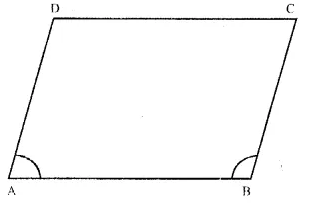
and ∠ B = 2x – 30° = 2 x 70° – 30°
= 140° – 30° = 110°
But ∠C = ∠ A and ∠D = ∠B
(opposite angles of a ||gm)
∠C = 70° and ∠D = 110°
Hence ∠A = 70°, ∠B = 110°, ∠C = 70° and ∠D = 110° Ans.
Question 8.
Solution:
In ||gm ABCD,
AB = 9.5 cm and perimeter = 30 cm
=> AB + BC + CD + DA = 30cm
=> AB + BC + AB + BC = 30 cm
( ∴ AB = CD and BC – DA opposite sides)

=> 2(AB + BC) = 30cm
=> AB + BC = 15cm
=> 9 5cm + BC = 15cm
∴BC = 15cm – 9.5cm = 5.5cm
Hence AB = 9.5cm, BC = 5.5cm,
CD = 9.5cm and DA = 5.5cm Ans.
Question 9.
Solution:
ABCD is a rhombus
AB = BC = CD = DA
(i)∴ AB || DC
∴ ∠ B + ∠ C = 180° (co-interior angles)
=> 110° + ∠C = 180°
=> ∠C = 180° – 110° = 70°
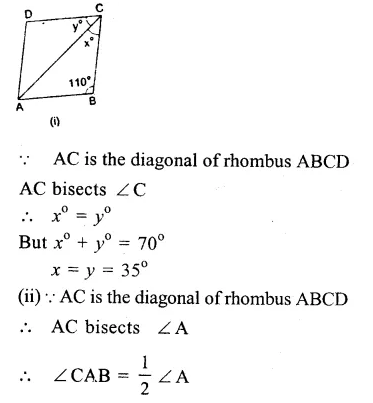
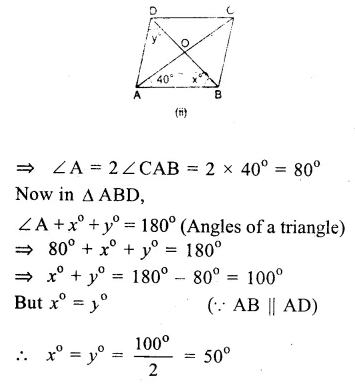

Question 10.
Solution:
In a rhombus,
Diagonals bisect each other at right angles
∴ AC and BC bisect each other at O at right angles.
But AC = 24 cm and BD = 18 cm
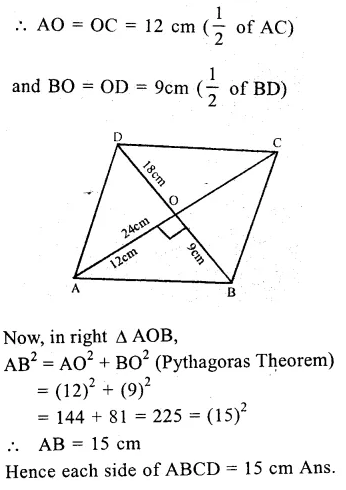
Question 11.
Solution:
Let ABCD he the rhombus whose diagonal are AC and BD which bisect each other at right angles at O.
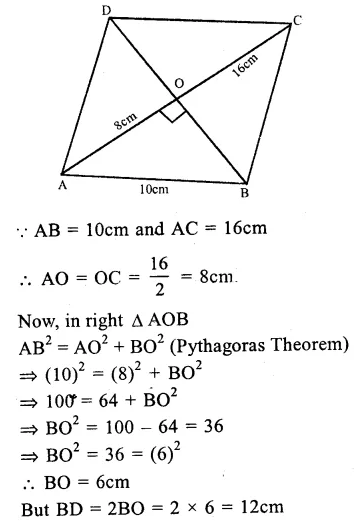

Question 12.
Solution:
ABCD is a rectangle whose diagonals AC and BD bisect each other at O.
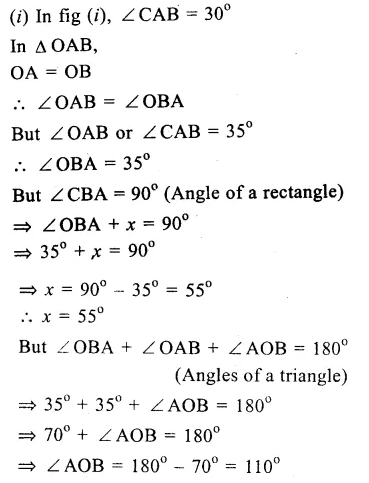
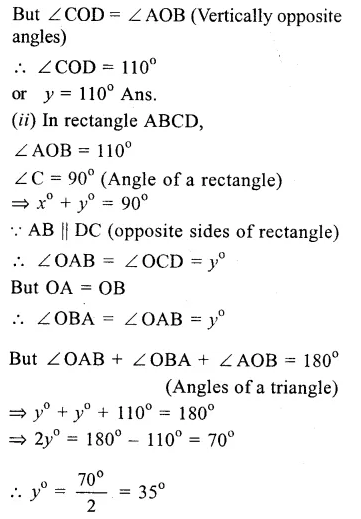
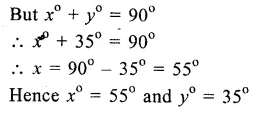
Question 13.
Solution:
ABCD is a square. A line CX cuts AB at X and diagonal BD at O such that
∠ COD = 80° and ∠ OXA = x°
∴∠ BOX = ∠ COD
(vertically opposite angles)
∴∠BOX = 80°
∴Diagonal BD bisects ∠ B and ∠ D
∴ ∠ABO or ∠ABD = ∠ ADO or ∠ ADB
∴ ∠OBA or ∠OBX = 45°
Now in ∆ OBX,
Ext. ∠ OXA = ∠ BOX + ∠ OBX
=>x° = 80° + 45° = 125° Ans.
Question 14.
Solution:
Given : In ||gm ABCD, AC is joined. AL ⊥ BD and CM ⊥ BD
To prove :
(i) ∆ ALD ≅ ∆ CMB
(ii) AL = CM
Proof : In ∆ ALD and ∆ BMC
AD = BC (opposite sides of ||gm)
∠L = ∠M (each 90°)
∠ ADL = ∠ CBM (Alternate angles)
∴ ∆ ALD ≅ ∆ BMC. (AAS axiom)
∴ or A ALD ≅ A CMB.
AL = CM (c.p.c.t.) Hence proved.
Question 15.
Solution:
Given : In ∆ ABCD, bisectors of ∠A and ∠B meet each other at P.
To prove : ∠APB = 90°
Proof : AD || BC
∠A + ∠B = .180° (co-interior angles)
PA and PB are the bisectors of ∠ A and ∠B
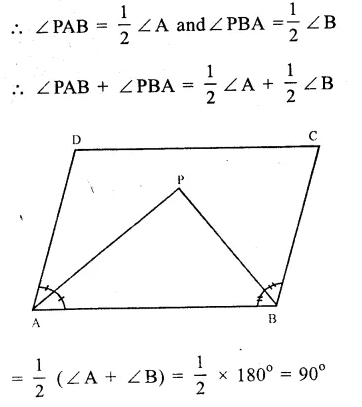
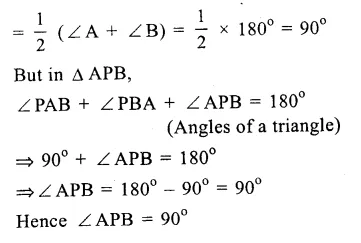
Question 16.
Solution:
In ||gm ABCD,
P and Q are the points on AD and BC respectively such that AP = 13 AD and CQ = 13 BC

Question 17.
Solution:
Given : In ||gm ABCD, diagonals AC and BD bisect each other at O.
A line segment EOF is drawn, which meet AB at E and DC at F.
To -prove : OE = OF
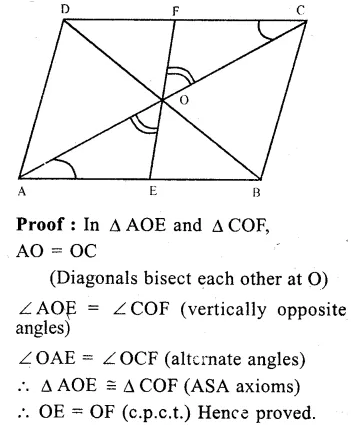
Question 18.
Solution:
Given : ABCD is a ||gm.
AB is produced to E. Such that AB = BE
DE is joined which intersects BC in O.
To prove : ED bisects BC i.e. BO = OC
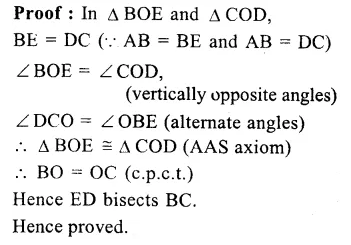
Question 19.
Solution:
Given : In ||gm ABCD, E is the midpoint BC
DE is joined and produced to meet AB on producing at F.

Question 20.
Solution:
Given : ∆ ABC and lines are drawn through A, B and C parallel to respectively BC, CA and AB forming ∆ PQR.
To prove : BC = 12 QR
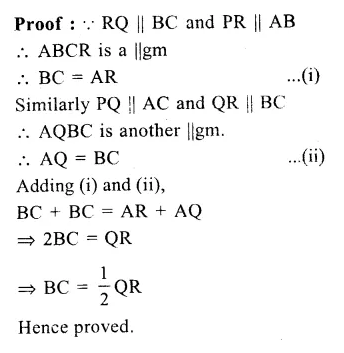
Question 21.
Solution:
Given : In ∆ ABC, parallel lines are drawn through A, B and C respectively to the sides BC, CA and AB intersecting each other at P, Q and R.
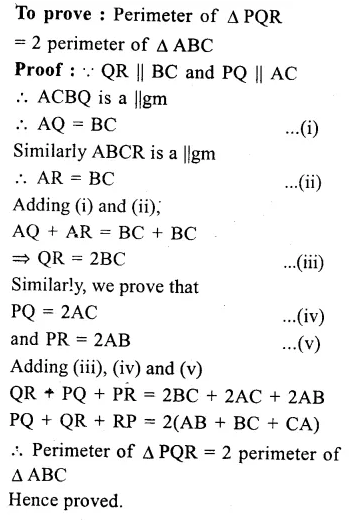
Ex 9C
Question 1.
Solution:
Given : In trapezium ABCD,
AB || DC and E is the midpoint of AD.
A line EF ||AB is drawn meeting BC at F.
To prove : F is midpoint of BC
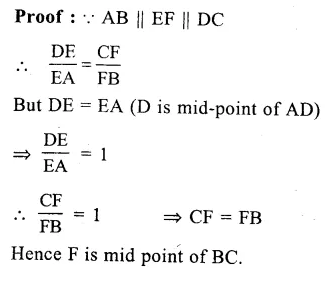
Question 2.
Solution:
Given : In ||gm ABCD, E and F are the mid points of AB and CD respectively. A line segment GH is drawn which intersects AD, EF and BC at G, P and H respectively.
To prove : GP = PH
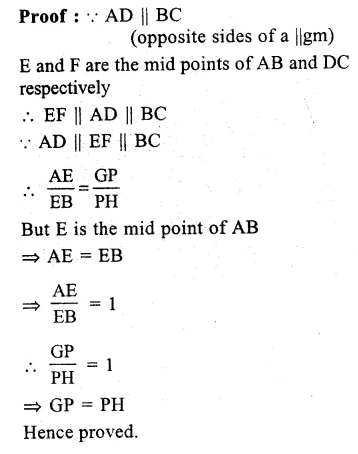
Question 3.
Solution:
Given : In trapezium ABCD, AB || DC
P, Q are the midpoints of sides AD and BC respectively
DQ is joined and produced to meet AB produced at E
Join AC which intersects PQ at R.

Question 4.
Solution:
Given : In ∆ ABC,
AD is the mid point of BC
DE || AB is drawn. BE is joined.
To prove : BE is the median of ∆ ABC.
Proof : In ∆ ABC
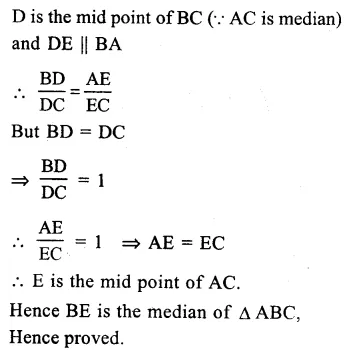
Question 5.
Solution:
Given : In ∆ ABC, AD and BE are the medians. DF || BE is drawn meeting AC at F.
To prove : CF = 14 BC.
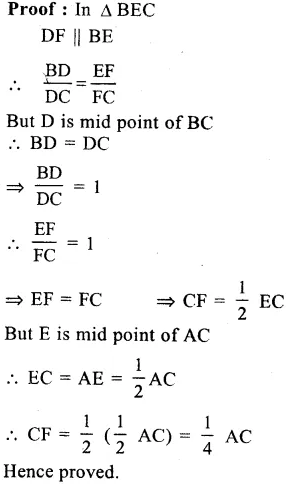
Question 6.
Solution:
Given : In ||gm ABCD, E is mid point of DC.
EB is joined and through D, DEG || EB is drawn which meets CB produced at G and cuts AB at F.
To prove : (i)AD = 12 GC

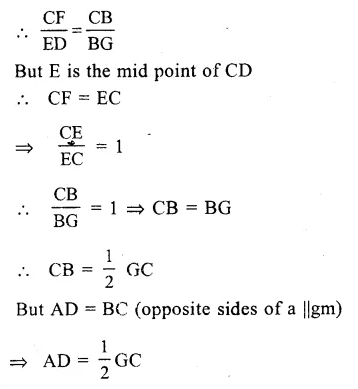
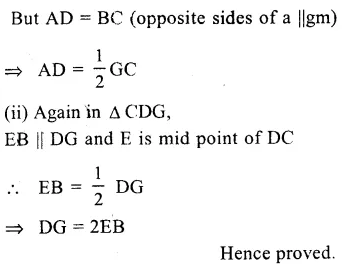

Question 7.
Solution:
Given : In ∆ ABC,
D, E and F are the mid points of sides BC, CA and AB respectively
DE, EF and FD are joined.
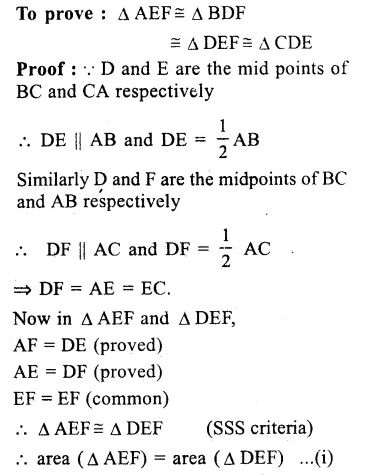
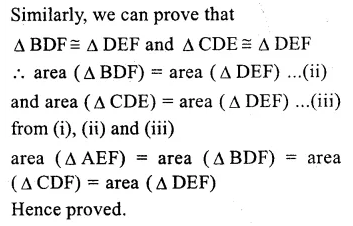
Question 8.
Solution:
Given : In ∆ ABC, D, E and F are the mid points of sides BC, CA and AB respectively

Question 9.
Solution:
Given : In rectangle ABCD, P, Q, R and S are the midpoints of its sides AB, BC, CD and DA respectively PQ, QR, RS and SP are joined.
To prove : PQRS is a rhombus.

Question 10.
Solution:
Given : In rhombus ABCD, P, Q, R and S are the mid points of sides AB, BC, CD and DA respectively PQ, QR, RS and SP are joined.
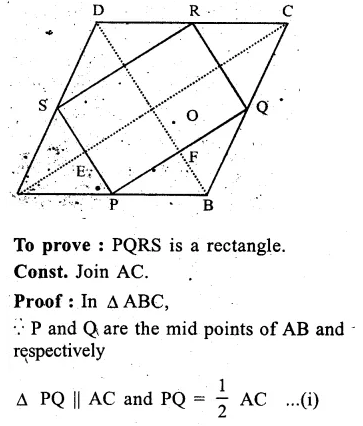
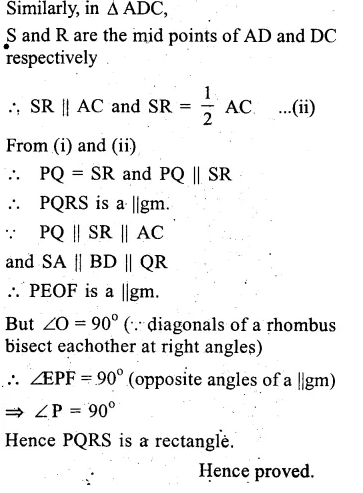
Question 11.
Solution:
Given : In square ABCD, P,Q,R and S are the mid points of sides AB, BC, CD and DA respectively. PQ, QR, RS and SP are joined.
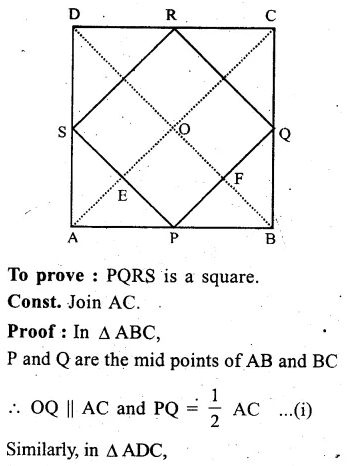


Question 12.
Solution:
Given : In quadrilateral ABCD, P, Q, R and S are the midpoints of PQ, QR, RS and SP respectively PR and QS are joined.
To prove : PR and QS bisect each other
Const. Join PQ, QR, RS and SP and AC
Proof : In ∆ ABC,
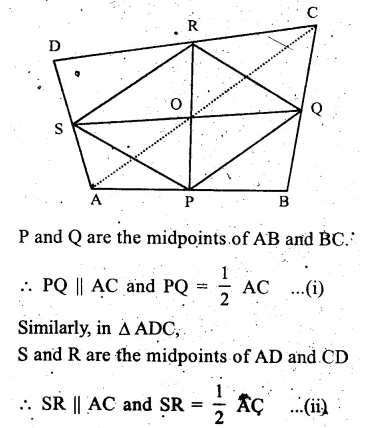

But diagonals of a ||gm bisect each other PR and QS bisect each other.
∴ PR and QS bisect each other
Question 13.
Solution:
Given : ABCD is a quadrilateral. Whose diagonals AC and BD intersect each other at O at right angles.
P, Q, R and S are the mid points of sides AB, BC, CD and DA respectively. PQ, QR, QS and SP are joined.


RS Aggarwal Solutions for Class 9 Maths Chapter 9: Download PDF
RS Aggarwal Solutions for Class 9 Maths Chapter 9–Quadrilaterals and Parallelograms
Chapterwise RS Aggarwal Solutions for Class 9 Maths :
- Chapter 1–Real Numbers
- Chapter 2–Polynomials
- Chapter 3–Introduction to Euclid’s Geometry
- Chapter 4–Lines and Triangles
- Chapter 5–Congruence of Triangles and Inequalities in a Triangle
- Chapter 6–Coordinate Geometry
- Chapter 7–Areas
- Chapter 8–Linear Equations in Two Variables
- Chapter 9–Quadrilaterals and Parallelograms
- Chapter 10–Area
- Chapter 11–Circle
- Chapter 12–Geometrical Constructions
- Chapter 13–Volume and Surface Area
- Chapter 14–Statistics
- Chapter 15–Probability
About RS Aggarwal Class 9 Book
Investing in an R.S. Aggarwal book will never be of waste since you can use the book to prepare for various competitive exams as well. RS Aggarwal is one of the most prominent books with an endless number of problems. R.S. Aggarwal’s book very neatly explains every derivation, formula, and question in a very consolidated manner. It has tonnes of examples, practice questions, and solutions even for the NCERT questions.
He was born on January 2, 1946 in a village of Delhi. He graduated from Kirori Mal College, University of Delhi. After completing his M.Sc. in Mathematics in 1969, he joined N.A.S. College, Meerut, as a lecturer. In 1976, he was awarded a fellowship for 3 years and joined the University of Delhi for his Ph.D. Thereafter, he was promoted as a reader in N.A.S. College, Meerut. In 1999, he joined M.M.H. College, Ghaziabad, as a reader and took voluntary retirement in 2003. He has authored more than 75 titles ranging from Nursery to M. Sc. He has also written books for competitive examinations right from the clerical grade to the I.A.S. level.
FAQs
Why must I refer to the RS Aggarwal textbook?
RS Aggarwal is one of the most important reference books for high school grades and is recommended to every high school student. The book covers every single topic in detail. It goes in-depth and covers every single aspect of all the mathematics topics and covers both theory and problem-solving. The book is true of great help for every high school student. Solving a majority of the questions from the book can help a lot in understanding topics in detail and in a manner that is very simple to understand. Hence, as a high school student, you must definitely dwell your hands on RS Aggarwal!
Why should you refer to RS Aggarwal textbook solutions on Indcareer?
RS Aggarwal is a book that contains a few of the hardest questions of high school mathematics. Solving them and teaching students how to solve questions of such high difficulty is not the job of any neophyte. For solving such difficult questions and more importantly, teaching the problem-solving methodology to students, an expert teacher is mandatory!
Does IndCareer cover RS Aggarwal Textbook solutions for Class 6-12?
RS Aggarwal is available for grades 6 to 12 and hence our expert teachers have formulated detailed solutions for all the questions of each edition of the textbook. On our website, you’ll be able to find solutions to the RS Aggarwal textbook right from Class 6 to Class 12. You can head to the website and download these solutions for free. All the solutions are available in PDF format and are free to download!
